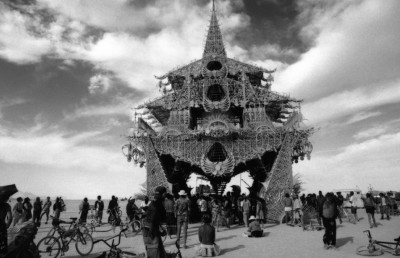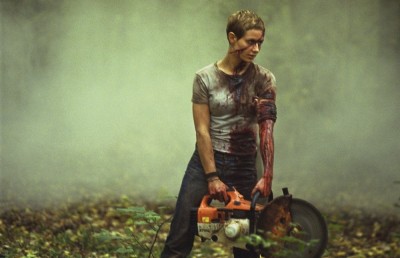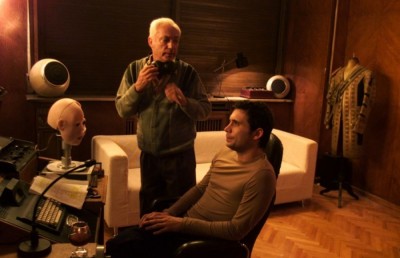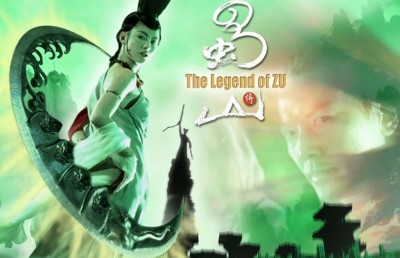Fantasia 2004 Part 1: Selections from Japan (mainly) and Korea
Nakata is Back
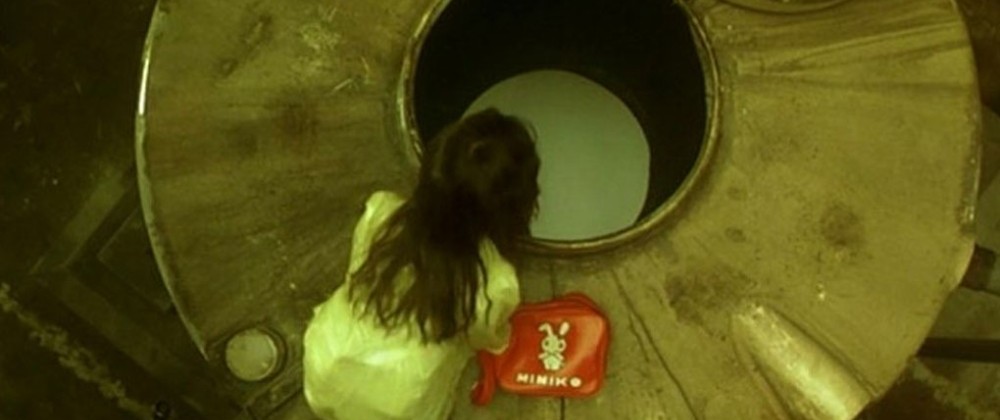
Returning to the friendly confines of Concordia University for the second year, Fantasia International Film Festival returns with its biggest program ever. The thickness of the festival catalogue, whose quality is head and shoulders above the catalogues which accompany pretty much every other festival in the city, is clear indication of the bulging program: over 100 features and 80 shorts.
On the surface there doesn’t seem to be any particular thematic links in the programming this year, as there was with last year’s influx of zombie films (although there ends up being quite a few zombies lurking about this year too). The one conscious programming decision which may turn out to be a regular feature if successful, is the decision to merge the fantastic worlds of comics and cinema. This year Fantasia is featuring a host of filmic adaptations of international comics (France, USA, Canada, Japan) and supplementing the onscreen cinema comics with a mini-convention weekend on the Hall Building’s mezzanine which features dealers, comic book artists, and demonstrations. In fact the first films to have sold out were the highly anticipated comic book adaptations from France, Immortel (Enki Bilal) and the Moebius directed Arzak Rhapsody. One of the festival coups is no doubt the rare anime by arthouse director Nagisa Oshima, Band of Ninja, from 1967. All seemed to go well except for the comic jam organized in the campus pub Reggie’s, which was hampered by technical problems, but managed to persevere through goodwill, sheer determination and patience. The ill-fated decision to choose the charmless Reggie’s as the festival’s official bar would be met with incredulity by anyone familiar with Concordia University’s social life. After a few half-hearted attempts to make the space work Fantasia guests and friends saw the light and left Reggie’s for greener pastures. Actually “whiter” pastures would be more fitting to describe the equally mistaken follow-up bar location “Meow,” with its 1980’s antiseptic sheen and “all-white” private 12 by 12 room, furnished with a wall-sized two-way mirror looking out into the bar’s main room and a singular white, airport styled couch wrapped around the room’s perimeter. Any bar where you have to argue your way passed a Neanderthal doorman is clearly not the right place for Fantasians. A much better time was had by all who ventured slightly farther to the homey confines of Cine Express, or the secluded alcove of the Madhatter rooftop terrace. Maybe the problem, compared to the old Imperial location, is that there are too many bars to choose from in this area of the city, but if there is a need next year to adopt an “official” bar for purposes of sponsorship, the task should be entrusted to someone familiar with the local bar scene. In any case, the regular Fantasia fans and guests are a resourceful bunch and the ‘right’ place will always reveal itself naturally.

Adele Hartley (of Dead by Dawn Festival) and FanTasia programmer Mitch Davis at Cine-express cafe
In part one of my report I will concentrate on the Asian programming, principally Japan and Korea, and return to the International programming in part two. In my report of last year I highlighted a critical difference between the recent horror national trends, Asian and Spanish with the recent Asian aesthetic horror trend which I pegged “frail, wispy aesthetic” (lots of blowing wind, billowing curtains, whispering sounds, slow motion, etc.), being opposed to the more realist-based Spanish horror films. There were no similarly themed Spanish horror films this year to contrast the Asian trend, only the bland marital thriller Killing Words (Laura Mãnà, 2003) [the Australian film Alexandra’s Project (2003) did a better job with similar material] and the semi-autobiographical Paul Naschy vehicle Rojo Sangre (Christina Molina), but many of the latter to continue the Asian trend, from Korea (The Uninvited, Tale of Two Sisters), Japan (Ju-On: The Grudge, One Missed Call, Bottled Fool), Vietnam (Oan Hôn), and Thailand (Buppah Rahtree). Japan was the best represented nation with close to 30 films, including the highly anticipated Kyoshi Kurosawa’s Doppelganger (from 2002), and, of course, a few from Takashi Miike.
Kyoshi Kurosawa’s Doppelganger did not disappoint with its slow burn descent from eerie uncertainty to a darkly ‘splintered’ comical turn on the age old doppelganger theme. Kurosawa employs formal tactics (optical splits of two and three frames) and battles between character alter egos to rejuvenate the doppelganger theme. The ubiquitous Kurosawa regular Yakusho Koji (Cure, Charisma, Séance, Pulse) plays Hayasaki Michio, a medical researcher working on an artificial body for the disabled. The clunky (and frankly absurd) machine looks like a fancy wheelchair with robotic arms sprouting out of its side and recalls the eating machine in Chaplin’s Modern Times. The first scene of the film, operating as conventional horror, sets up the doppelganger theme, as a young woman, Yuka Nagai (Hiromi Nagasaku) sees her brother at a mall and asks him if he wants a ride home. He refuses and walks away, but when she arrives home she sees her brother sitting in the living room watching television, oblivious to the encounter at the mall. A phone call from the police informs her that they have found the body of her dead brother, and when she searches the apartment the brother is nowhere to be found, while an open window with billowing curtains is visible in the background.
With his invention at a standstill Hayasaki begins to feel enormous pressure from the corporate management funding his project. It is at this point that Hayasaki’s double makes his appearance and begins to aggressively engineer Hayasaki’s career path and personal life by smashing up his laboratory and stealing the machine (which gets him fired), murdering and robbing one of the corporate sponsors (which gives him the necessary funding to continue his research without any corporate pressure), and making love to Yuka, whom he was in love with but never had the nerve to approach (which initiates a long term relationship between Hayasaki and Yuka). Only after the ‘new’ Hayasaki emerges is he able to ‘murder’ his double by repeatedly hitting him in the head with a wrench during a confrontation scene in his new laboratory, in full view of his newly formed work group, assistants Kimishima (Yusuke Santamaria) and Yuka. Not unlike other doppelganger films, the double represents a more aggressive alter ego (Wolf for example). What Kurosawa adds to the doppelganger mythology is the complete removal of any supernatural or overtly horrific connotations. Hayasaki’s double just appears, without any magic potion, wolf bite, or serum. The appearance of the double is tied directly to the pressures of modern life.
Yakusho Koji’s dual performance as Hayasaki and his double is outstanding. Since they are always dressed identically it becomes exceedingly difficult to tell them apart, especially when the real Hayasaki begins to adopt the more aggressive attitude of his double. At times all we have to distinguish them, especially in scenes where they are separate, is Koji’s nuanced performance. Unfortunately the film becomes less interesting after Hayasaki’s double leaves the picture. The last thirty minutes of the film is comprised of Hayasaki driving with Yuka and Kimishima to deliver the artificial body to a new Medical company. The drive becomes complicated when Kimishima wants the invention for himself and Hayasaki must thwart both Kimishima and his former manager Murukami from abducting his artificial body. In the end he succeeds, only to turn around and decide to destroy the artificial body and all the fame, money and corporate greed that comes along with it, to start life anew. The final ocean front scene sets up the film’s most absurd and liberating image. In long shot, we see Hayasaki set the artificial body ‘free.’ With its robotic arms flailing like a happy child, the machine slowly inches its way toward and over the cliff. Since the artificial body is nothing more than another ‘double,’ its destruction represents Hayasaki’s final liberation from his past.
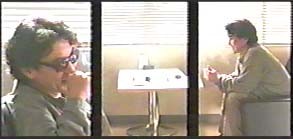
Doppleganger
Another entry from Japan is Yudai Yamaguchi’s feel-good movie Battlefield Baseball (onscreen title Battlefield Stadium), which spoofs itself at every turn. Don’t expect any realistic baseball footage, but rather baseball as a conceptual prop for a _West Side Story_-styled tale of high school competition taken to violent extremes. The zany use of musical numbers recalls Miike’s Happiness of the Katakuris, and Yamaguchi adds some clever touches, such as having characters enter the frame as non-diegetic spectators applauding key on-screen moments. The unabashed zaniness may infuriate some viewers, but the midnight crowd I saw it with enjoyed the film to ecstatic proportions.
Fantasia would not be complete without at least two or three Takashi Miike films. This year features three, the wildly bizarre ‘yakuza horror’ Gozu, Deadly Outlaw Rekka, and the outright horror film One Missed Call. I missed the middle film but was not disappointed with the other two Miike efforts. I was particularly anticipating the latter film to see what someone as unabashedly original and iconoclastic as Miike would do to jumpstart the post-Ringu horror aesthetic. Apparently this movie represents Miike’s attempt to make a straightforward movie, and to a large extent, this is what he achieves. Where Miike adds an interesting twist is in playing a very fine line between parodying the Ringu tropes and abiding by them. So what we get is a horror movie that alternates between using the traditional Ringu scare tactics (technology, in this case a cell phone’s message, foretelling when a character will die, black-haired female ghosts lurking in the dark, inquisitive victims, etc.) and abusing them to comic effect (i.e. the sound of an inhaler being absurdly amplified to garner a startle effect). There is little doubt that Miike knows how to use the tools of the horror genre to devastating effect, as the penultimate lengthy scene at the abandoned hospital which pits the heroine/survivor against a malevolent spirit haunting the hospital corridors demonstrates.
Miike returns to his usual twisted senses in Gozu. While watching this bizarre yakuza film I had an uneasy feeling of Miike repeating himself by being kinky and weird for its own sake, but there are enough sublimely surreal moments and an wholly unexpected ‘birthing’ scene which makes this near top-drawer Miike. The film begins as a twisted yakuza yarn, introducing lowly bodyguard Ozaki, a walking time bomb who sees potential danger at every innocuous situation (i.e. he thinks a tiny poodle outside the restaurant where the yakuza leader is dining is a trained ‘anti-yakuza’ dog and goes out onto the sidewalk to whip n’ thrash the poor dog to death in front of its terrified owner and onlookers). Minami is given orders to take Ozaki out into the countryside to execute, but Minami mysteriously loses Ozaki and the film transforms into a road journey of self-discovery for Minami. Ozaki returns transformed into a woman and then is reborn again as a man from the same (his?) woman’s womb. The gooey, gelatin-over- blood birth recalls the shunting orgy at the end of Brian Yuzna’s Society. And then there is the gangster who can only maintain an erection with a ladle planted up his anus. You will never think of ladles in quite the same way!
Three other Japanese films, two newish, one old, left a strong impact, Ritual (2000 Hideaki Anno), Bottled Fool (2004, Hiroki Yamaguchi), and Godzilla (1954, Ishiro Honda). Ritual had the benefit of its star’s presence, Ayako Fujitani (daughter of Steven Seagal), who introduced the film and hosted a question and answer period (as do all invited guests at Fantasia, something the World Film Festival could learn from). Ritual, which is based on a novel written by the young Fujitani, is an abstract ‘trauma’ film which plays out like a young Japanese female’s 8 ½ (and in this respect has something in common with Asia Argento’s semi-autobiographical Scarlet Diva). The film moves on in a charmingly aimless fashion echoing its central character’s state of mind, with recurring visual and geometric symbols (train tracks, umbrellas), colors (red especially), and thematics (suicide) which work very well when they are kept vague and illusory. Yayako plays the young woman who wanders through the city in search of love and redemption from some past traumatic experience, followed every step of the way by a filmmaker using her as a subject for his next film (played by real life director Iwai Shunji). Yayako is fascinating to watch in a powerful performance aided by formal elements which underscore her fragile and volatile state of mind. For example, the art direction, especially her huge apartment which is designed to look like more like a compartmentalization of her life in physical prop than a livable space; costume design (Ayako must have gone through 100 wild and colorful costume changes); and a camera style that echoes Ayako’s boundless physical energy and emotional inertia (long takes that are in constant movement in one shot and then static in another). Unfortunately, the film becomes less interesting in the last few scenes when Ayako’s ‘trauma’ (and the visual symbols used to suggest the trauma) is explained through her family history. The ‘rational’ resolution does however lead to one stunning moment: an emotional mother-daughter confrontation scene that puts to shame similar moments in reality-TV lexicon (i.e The Jerry Springer Show sibling/parent showdowns). Director Hideaki simply places the camera behind a seated Fujitani and her mother and leaves it running continuously and without movement while the two women wage an emotional war of catharsis.
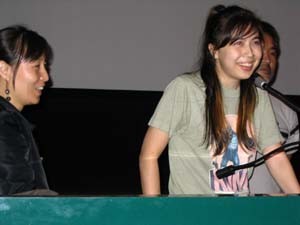
Ayako Fujitani introduces Ritual, with FanTasia programmer Mi-jeong Lee
I will go out on a limb and state that the director of Bottled Fool, Hiroki Yamaguchi, is a name to keep an eye on because he could possibly become the next big thing out of Japan. Bottled Fool is a low budget film, part horror, part science-fiction, which thrives on its self-imposed limitations (it is set mainly in one location, a freight elevator) and is brimming with fascinating ideas, visual, sonic, and thematic. Yamaguchi begins with an often used science fiction premise of a geographically stratified society (underground/above ground). This plot, often used as a form of geopolitics, goes as far back as H.G. Well’s The Time Machine and Fritz Lang’s Metropolis, right on through to Planet of the Apes and Bladerunner. In Yamaguchi’s young hands the premise maintains the geopolitical edge but is modernized by manga-styled visuals (inventive camera angles, varied color textures, and intense violence). In the film’s premise people travel vertically in elevators to various city floor ‘levels.’ A varied group of passengers, including two teenagers, a mother and her baby, a scientist, and the elevator girl, are terrorized when two psychotic inmates overwhelm and murder the policeman escorting them to the prison level. One of the escaped inmates, a serial rapist-murderer played by actor Keisule Urushizaki, should go done as one of the most terrifying psychos in cinema history.
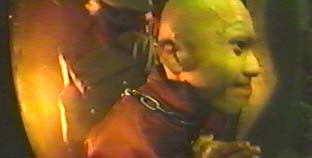
Serial killer/rapist, played by Keisule Urushizaki
The film becomes a study of how people behave in moments of prolonged confinement and duress, but the simple premise is enlivened by clever and unexpected character and narrative revelations. As the director revealed to me in an interview (to be published in an upcoming issue of Offscreen), the overriding theme in the film is ‘preconception’ and how people can be easily fooled by them. Accordingly, none of the characters can be trusted to be who they appear to be on the surface. The film’s non-linear structure allows breathing space from the singular and claustrophobic setting by cutting away to police interrogation scenes that are set after the elevator event, and shots representing one of the central character’s subjective visions (one of the film’s revelations is that the two trapped teenagers are telepaths). The film is so full of invention that even the film’s final shot leaves the audience intellectually flabbergasted. In the final scene an inmate is being escorted to the prison level, which we expect to be a terrifying penal environment. The elevator doors open and there is a cut to the ‘prison’: a brief flash shot of the Tokyo cityscape at night.
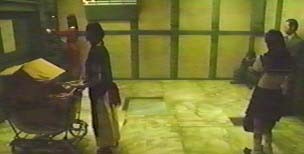
Mother & daughter arrive at the apartment
Seeing a brand new 35mm print of the Japanese version of the classic monster movie, Godzilla (1954), was one of the festival highlights. In dropping the footage filmed by Terry Morse featuring American newspaper man Steve Martin (Raymond Burr), the Japanese version is starker and more forthright in its anti-war message. The scenes with the bitter one-eyed scientist Serizawa (who presumably lost his eye in the war) who invents the powerful weapon which ultimately destroys Godzilla are filmed with an unerring attention to dark shadows and neo-noir lines. The visual style underscores atmosphere over realism. The scientist is reticent to let the authorities know about his powerful “Oxygen Destroyer” for fear of it falling into the wrong hands. He agrees to using it against Godzilla after much social pressure, but his redemption comes at a great cost as he commits suicide in the process of ‘killing’ Godzilla so that the his formula dies with him. The monster that raises from the depths of the ocean floor because of nuclear radiation is commonly seen as a metaphor for the atomic bomb, but more astute observers see the prehistoric behemoth as a metaphor for Japan, and the destructive weapons used to combat Godzilla –in this case the “Oxygen Destroyer”- as the fearful, apocalyptic power. This makes sense given the sympathetic aura surrounding Godzilla in most of his reincarnations, and the fact of his indestructibility.
Before leaving behind Japan, it is perhaps fitting that the Festival’s best horror film came from the director who started off the recent post-_Ringu_ Asian horror movie craze, Hideo Nakata. Dark Water (2002) sees Nakata returning to similar aesthetic terrain as Ringu, with a streamlined, less convoluted narrative set in modern contemporary Japan. Like Ringu, Dark Water features two strong female leads, in this case a young, emotionally fragile mother Yoshima Matsubara (Hitomi Kuroki) and her five-year old daughter Ikuko (Rio Kanno). Unlike the folkloric supernaturals of Ringu, Dark Water couches its horror in the reality of everyday, with Yoshima Matsubara fighting her estranged husband for custody of their child, and negotiating the pressures of single motherhood. This plot point is part of what raises Dark Water above the slew of Ringu copies that have come out of Asia in recent years. Simply put, we care about these two characters and hence do not need a string of hapless victims to generate fear. As if attempting a conscious antidote to _Ringu_’s technological horrors (the cursed video tape), Nakata generates fear out of the mundane and the natural: primarily water as it leaks its way through the walls, ceilings, and pipes of the murky, dank tenement building into which Yoshima and her daughter have just moved.
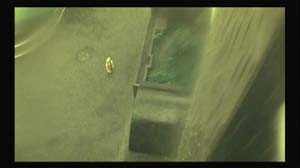
The ghostly girl in yellow raincoat
The omnipotent water functions not only as a sign of the ghostly presence of a little girl, but of Yoshima’s own growing mental anguish. Anyone who is a home owner can attest to the mystery of plumbing; and Nakata takes full advantage of both the photogenic quality of water and the horrifying potential of plumbing. In fact water and plumbing have an impressive tradition in the annals of horror. Think of the shower scene in Psycho and the bathtub scene in Diaboloque; the apocalyptic rains and tidal waves in The Last Wave; the drowning of the little girl in the opening of Don’t Look Now (which Nakata perhaps alludes to with the ghost girl’s yellow raincoat); the dread surrounding the bathroom of room 237 in The Shining; or the disquieting plumbing in Chasing Sleep. As an interesting aside, Dark Water has as much in common with The Sixth Sense as Ringu, with the close single parent/child relationship, the key scenes set in domestic spaces, and a ghost child haunting their abode. Unfortunately, Nakata missteps with the coda scene which flash forwards ten years to Ikuko as a high school student who revisits the tenement to visit with the ghost of her mother. The light, redemptive tone of this scene is so at odds with the rest of the film that one has to wonder why Nakata decided to include it (pressure from the producers to give the film a happy ending?).
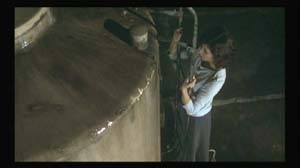
The ‘well’ in Ringu is replaced by the water tank in _Dark Water_…and no less terrifying
Behind Japan in quantity but not quality was the cinema of Korea, which featured some of the festival’s best and most highly attended films. The range in the Korean programming was impressive, from stand-out comedies with strong social edge such as Save the Green Planet (Jang Jun-hwan, 2003) a bizarre concoction of anti-war social message film and zany slapstick which reinvents both comedy and science-fiction), Jail Breakers (Sang-jin Kim, 2002), and Sex is Zero (Je-Gyun Yun, 2002); to one of the best serial killer films of recent years and which will surely grow in stature over the years, Memories of Murder, to the gender-bending gangster film turns redemption-romance Failan, and to two of the festival’s strongest horror entries, A Tale of Two Sisters (Ji-woon Kim, 2003) and The Uninvited. With the latter two films directors Lee Soo-Yeon of The Uninvited (first Korean female horror director) and Ji-Woon Kim manage to steer clear of Ringu’s large shadow and cast their own idiosyncratic and compelling takes on the trauma of loss (The Uninvited) and family psychosis (Two Sisters). The only two Korean films which disappointed were Natural Cities (Byung-chun Min, 2003) and Sword in the Moon (Ui-seok Kim, 2003), the former a large scale science-fiction film which starts off strong, with an intriguing sequence of the future society’s genetic engineering sub-structure, before devolving into a misguided Blade Runner copy that stumbles along as a shoot-em-up actioner; the latter a 17th century Korean chamber film whose loose political overtones become an all-too obvious metaphor for Korean unification. In the film’s final battle two warriors, bloodied and wounded, stand with their backs together in preparation for their suicidal last stand against an army. One of them says to the other, “I want to go back to the old days.” With its barely disguised message of Korean unification, Sword in the Moon echoes the contemporary crime thriller Swiri (Je-gyu Kang, 1999), which also ended with a similar metaphoric climactic battle.
The one Korean film I will elaborate on is Memories of Murder by Joon-jo Bong (Barking Dogs Never Bite), a fascinating serial killer film that shifts gears from being a standard procedural cop drama for the first ¾, to a metaphysical meditation on the psychological trauma of continuous exposure to violent seriality. The film opens on a pastoral country setting, circa 1986, with a close-up of a little boy. The shot cuts to a group of people coming down a dirt road in the distance. Two police officers look into a large road-side gutter. We cut to a POV and see the putrid, fly-filled corpse of a young woman. This marks the first in a series of bizarre small-town murders that puzzle the local police, led by an older lieutenant and good cop/bad cop pairing of Du-man Park (Kang-ho Song) and his hothead partner Yung-gu Jo (Roe-ha Kim). The rural officers, whose methods of investigation include mental and physical torture of suspects, planting of evidence, and relying on ‘intuition’ and fortunetelling, are clearly out of their league. They are soon joined by big city (Seoul) detective Tae-yun Seo(Sang-kyung Kim), who watches their outmoded and corrupt procedures with disdain and indifference.
The first important set of clues are deduced by lowly female police officer Gui-ok (Seo-hie Ko), who discovers that on each murder night a request for the same song, “Sad Letters,” was sent to a local radio station written on a post card; and that it was raining on each of those nights. The narrative settles on three potential suspects: a local mentally ill boy; a man caught masturbating near a murder site; and a factory worker who is tied to the murder because of circumstantial evidence (his address matches that on the postcards).
Detective Park believes he has the ability to ‘intuit’ the culpability of a person by looking into their eyes. One scene reveals the self-doubt lurking beneath the surface veneer of his intuitive powers, and which will come back to devastating effect near the film’s end. The second suspect is caught by the police masturbating in the woods near the murder site. We clearly see that the man is wearing red panties underneath his pants. The police chase the suspect but lose him among a busy construction site. While scanning the construction workers from afar, Park spots a man bending down to reveal a pair of red panties beneath his pants. To impress the city cop he pretends that he has picked the man out of the group using his famous intuitive “look into my eyes” routine (shades of Hank Quinlan from A Touch of Evil?). Park’s intuitive ‘skill’ is used as a comic device until the conclusion, where his intuition becomes part of the house of cards which helplessly crumbles to the ground.
The emotional wear and tear on the officers of seeing this type of cruelty and horror begins to take its toll. On top of that, Park’s partner Jo has to have his leg amputated after he carelessly neglects a stab wound inflicted by a rusty nail. Park is the person who has to authorize the operation, and the pain on his face is evident. When semen sample is found on the latest crime scene a break in the case appears imminent. Since Korea does not yet have the technology to process the sample, it is sent to America to make a DNA test against the suspect’s. By now the city cop Seo, perhaps under the pressure of constant failure, has taken to the local police methods. In the film’s climax and best set-piece, Seo chases the suspect to a deserted train track just outside a tunnel and attempts to beat a confession out of him. Seo takes his gun out and points it at the killer. Before he can pull the trigger Park arrives and, ironically, stops him from the police brutality. Park has the DNA evidence. Seo takes the paper and goes into the tunnel out of the rain to read the report: the results are inconclusive. By now Seo has lost touch with any semblance of police procedure and once again threatens to kill the suspect. Detective Park grabs the suspect and performs his intuitive ‘look into my eyes’ test on him. The gesture plays out longer than usual. At last, Park acknowledges that he is no intuitive magician. This gesture, which had been used for comic effect the whole film, now becomes a desperate last ditch effort at sanity. He lets his grip go and the suspect runs into the tunnel. The city cop fires a shot that seems to hit the fallen suspect, but moments later he rises and slowly walks away into the tunnel’s darkness never to be seen again. This is also the last we see of the city cop Seo.
In this crucial scene, both science and intuition have let the Park down. What more can he do to serve the law? Nothing. The scene fades to an intertitle that reads “2003.” We see Park sitting at a kitchen table, slightly older, with his family. Cut to him in the back of a truck delivery a box of commercial products. Park has left the police force and has settled into a live of domesticity as a salesman. He asks the driver to stop by a deserted road. We are back at the location of the opening scene, the scene of the first murder. The scene echoes the opening in many ways. He looks into the same road-side gutter, and now a little girl comes and asks him why he is looking in the gutter. She tells him that another man did the same thing earlier in the day. Park asks the little girl if she knows why the man looked into the gutter, and she replies that the man had said this was the place where something happened a long time ago. The shot cuts to a close-up of Park’s face staring into the camera in deep thought. The film’s title now gains its meaning. Two thoughts are going through Park’s mind: was that man the killer, still at large and basking in his former glory? Or was it Seo, the city cop, himself also haunted by this shared past? In the end it does not matter. What does is the unsettling, haunting quality the film has now attained. By the time the film reaches its conclusion the audience is as emotionally exhausted as the two central characters, who have come to the sinking realization that they are unable to protect society from its sickest and cruelest…or escape from their own “memories of murder.”
Like many serial killer films, Memories of Murder is based on a true account, South Korea’s first recognized serial killer case, which occurred between 1986 and 1991. The traumatic nature of the murders is augmented by cinematographer Hyung-gu Kim’s earthy, sepia-toned recreation of sleepy, rustic small-town life (set in Korea’s Gyeonggi Province). The violent nature of the crimes seem that much more heinous and otherworldly when set off against such an apparently idyllic setting. Since the case still remains unsolved, it is not very optimistic when it comes to the law’s ability to protect society from its weakest, sickest, and cruelest. This is a serial killer film with a twist. In the end, there is no resolution. The serial killer is not found. The audience is left hanging like the police officers, unprotected in its state of mind. Even during the investigation, there is none of the usual profiling. The detectives do not ask and do not seem to care about the killer’s motives. Even the city cop never asks or wonders about the all important “motive.” All of this uncertainty, coupled with the admission of failure on the part of the police, makes the film anything but socially reassuring.
Fantasia 2004 Part Two: Selections from the International Programming



